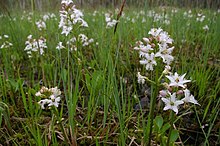Menyanthes
| Menyanthes | |
|---|---|

| |
| Scientific classification | |
| Kingdom: | Plantae |
| Clade: | Tracheophytes |
| Clade: | Angiosperms |
| Clade: | Eudicots |
| Clade: | Asterids |
| Order: | Asterales |
| Family: | Menyanthaceae |
| Genus: | Menyanthes L. |
| Species: | M. trifoliata
|
| Binomial name | |
| Menyanthes trifoliata | |

Menyanthes is a monotypic genus of flowering plants in the family Menyanthaceae containing the single species Menyanthes trifoliata. The name Menyanthes comes from the Greek words menyein, meaning "disclosing", and anthos, meaning "flower", in reference to the sequential opening of flowers on the inflorescence. The North American form is often referred to as M. trifoliata var. minor Michx. It is known in English by the common names bogbean[1] and buckbean.
Characteristics
Menyanthes trifoliata has a horizontal rhizome with alternate, trifoliate leaves. The inflorescence is an erect raceme of white flowers.
Menyanthes trifoliata occurs in fens and bogs in Asia, Europe, and North America. In eastern North America, it is considered to be a diagnostic fen species.[2] It sometimes creates big quagmires with its thick roots.
It has a characteristic strong and bitter taste, which can be used in schnapps.
References
- ^ "BSBI List 2007". Botanical Society of Britain and Ireland. Archived from the original (xls) on 2015-01-25. Retrieved 2014-10-17.
{{cite web}}: Unknown parameter|deadurl=ignored (|url-status=suggested) (help) - ^ Godwin, Kevin S.; Shallenberger, James P.; Leopold, Donald J.; Bedford, Barbara L. (2002). "Linking landscape properties to local hydrogeologic gradients and plant species occurrence in minerotrophic fens of New York State, USA: A Hydrogeologic Setting (HGS) framework". Wetlands. 22 (4): 722–37. doi:10.1672/0277-5212(2002)022[0722:LLPTLH]2.0.CO;2.
External links
 Media related to Menyanthes trifoliata at Wikimedia Commons
Media related to Menyanthes trifoliata at Wikimedia Commons Data related to Menyanthes trifoliata at Wikispecies
Data related to Menyanthes trifoliata at Wikispecies- Jepson Manual Treatment
- USDA Plants Profile
- Photo gallery
